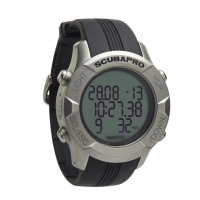immediate action by the diver. Alarms are
described in the following chapters.
WARNING
- When in GAUGE mode, all warnings and all
alarms are OFF except for the low battery alarm.
- When MANTIS is set to SOUND OFF mode, all
audible alarms and warnings are switched off.
4.8.9.5 Ascent rate
As you ascend during a dive, the pressure
surrounding you diminishes. If you ascend
too quickly, the resulting pressure reduction
could lead to microbubble formation. If you
ascend too slowly, the continued exposure
to high ambient pressure means you will
continue loading some or all of your tissues
with nitrogen. Consequently, there is an
ideal ascent rate that is slow enough to
minimize microbubble formation yet fast
enough to minimize the effect of continued
loading on your tissues.
The pressure reduction that the body can
tolerate without significant microbubble
formation is higher at depth than it is in shallow
water: The key factor is not the pressure drop
itself, but rather the ratio of the pressure drop
relative to the ambient pressure. This means
that the ideal ascent rate at depth is higher
than it is in shallow water.
DEPTH ASC SPEED
m ft m/min ft/min
0 0 7 23
6 20 8 26
12 40 9 29
18 60 10 33
23 75 11 36
27 88 13 43
31 101 15 49
35 115 17 56
39 128 18 59
44 144 19 62
50 164 20 66
If the ascent rate is greater than 110% of
the ideal value the SLOW symbol appears.
For ascent rates higher than 140%, the
SLOW symbol starts blinking.
MANTIS also provides an audible alarm
in case ascent rates exceed 110%: the
intensity of the alarm increases in direct
proportion to the degree that the ideal
ascent rate is exceeded.
In case of a fast ascent, MANTIS may
require a decompression stop even within
the no-stop phase because of the danger
of microbubble formation.
From great depth a slow ascent may
cause heightened saturation of tissues
and an extension of both decompression
duration and total ascent time. At shallow
depth, a slow ascent may shorten the
decompression duration.
Excessive ascent rates for longer periods
are entered in the logbook.
WARNING
The ideal ascent rate must not be exceeded at
any time since this could lead to microbubbles
in the arterial circulation which could cause
serious injury or fatal issue.
The alarm persists for as long as the ascent
rate is 110% or more of the ideal ascent rate.
4.8.9.6 MOD/ppO
2
WARNING
- The MOD should not be exceeded. Disregarding
the alarm can lead to oxygen poisoning.
- Exceeding a ppO
2
of 1.6bar can lead to
sudden convulsions resulting in serious
injury or fatal issue

